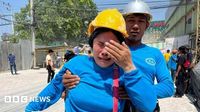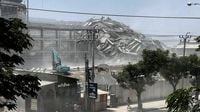A powerful 7.7 magnitude earthquake struck central Myanmar on March 28, 2025, sending shockwaves across the region, including Myanmar’s largest city, Yangon, and neighboring Bangkok, Thailand. The tremor, which occurred at a shallow depth of 10 kilometers (6.2 miles), caused widespread panic as buildings swayed, prompting people to rush outdoors in fear.
The epicenter was located approximately 16 kilometers (10 miles) northwest of the city of Sagaing at around 12:50 PM local time (0620 GMT), according to the United States Geological Survey (USGS). Reports indicated that roads were buckled in the capital Naypyidaw, with chunks of ceilings falling from buildings, and social media posts from Mandalay depicted scenes of destruction, including collapsed buildings and debris littering the streets.
In Yangon, the country's largest city, residents poured out into the streets, leaving buildings behind as they braced for aftershocks. Witnesses described a harrowing scene, with one recalling watching a five-story building crumble as terrified residents fled their homes. "I heard it and I was sleeping in the house, I ran as far as I could in my pyjamas out of the building," said Duangjai, a resident of the popular northern tourist city Chiang Mai.
The tremor also reached Bangkok, where startled office workers and hotel guests flooded the streets, many in bathrobes or swimming attire, as tremors caused high-rise towers to sway for at least two minutes. One office building in downtown Bangkok experienced significant movement, causing windows and doors to creak and alarms to blare. Workers evacuated via emergency stairs, some in shock, while medical staff tended to the elderly and those in distress outside.
Thai Prime Minister Paetongtarn Shinawatra, who was on an official visit to the southern island of Phuket, interrupted her trip to hold an urgent meeting following the earthquake. Some metro and light rail services were suspended in Bangkok due to the quake.
As the situation unfolded, initial reports indicated no immediate casualties in either Myanmar or Thailand; however, the full extent of the damage in Myanmar remained unclear due to communication challenges, especially amid the ongoing civil unrest in the country. The Myanmar Fire Services Department reported that they had begun searching Yangon for casualties and damage, stating, "We have started the search and going around Yangon to check for casualties and damage. So far, we have no information yet."
In the immediate aftermath, the tremors were felt not only in Myanmar and Thailand but also in China's southwest Yunnan province, where Beijing's quake agency measured the jolt at 7.9 in magnitude. The earthquake served as a stark reminder of the region's vulnerability to seismic events, particularly in densely populated areas like Bangkok, which is home to more than 17 million people.
Although initial reports did not indicate structural damage in Bangkok, the tremor was strong enough to send water splashing out of rooftop pools in the Thai capital. A high-rise building under construction in Bangkok collapsed, trapping 43 workers, according to reports from the Associated Press. The situation is still being monitored as authorities continue their search for any signs of casualties or further destruction in both countries.
Earthquakes are relatively common in Myanmar, where six strong quakes of 7.0 magnitude or more struck between 1930 and 1956 near the Sagaing Fault, which runs north to south through the center of the country. A powerful 6.8-magnitude earthquake in the ancient capital Bagan in central Myanmar killed three people in 2016, also toppling spires and crumbling temple walls at the tourist destination.
This latest earthquake has raised concerns about the region's preparedness for such natural disasters, especially given the challenges faced by Myanmar's healthcare system, which is already strained due to ongoing political turmoil. As residents continue to assess the damage and seek safety, the full impact of the earthquake is yet to be determined.








